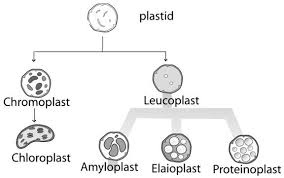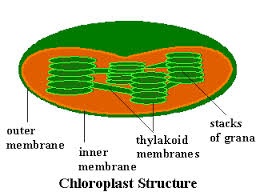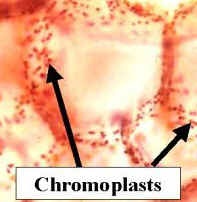Detail of organelles:
Plastid:
They are only present in plant cell. They are of three types.
1. Chloroplasts
2. Leucoplasts
3. chromoplasts

1) Chloroplasts:
They are sites of photosynthesis in green plants. Green leaves contain chloroplast. Chloroplast contains chlorophyll, the green pigment necessary for photosynthesis.
Each chloroplast is bound by double membrane. Inside is a semi fluid colorless, gelatinous matrix called stoma. The inner membrane gives rise to membranous stack which is called “Granum”. Each granum has flattened sacs called "Thylakoids". Chlorophyll pigments are present in thylakoids.

2) Leucoplasts:
They are colorless. They are present in the cells of those parts where food is stored like roots. They store starch, proteins and lipids.
3) Chromoplasts:
They contain bright colors except green color. They are present in the petals of flower and skin of the fruits. They help pollination and dispersal of fruit.

Centrioles:
They are present in animal cell. They are also present in many unicellular organisms. They are hollow and cylindrical structure about 0.2 micrometer diameter. They arise in different region of the cytoplasm.They make some protein fibers, which help in the movement of chromosomes in spindle formation during cell division. They are absent in plant cell. Animal cells have two centrioles which are collectively called Centrosome.

Vacuole:
Vacuole is the fluid filled sacs bounded by a membrane. In plant cell one large central vacuole is present. In animal cell many small vacuoles are scattered. It gives strength and support to the cell. Vacuole of a plant cell contains a solution of amino acid, mineral salts, sugars, wastes and also red or purple pigments called Anthocyannis. In unicellular organisms, water and waste materials are excreted by contractile vacuoles while food is digested in food vacuole. Vacuoles absorb water from the surrounding and become turgid.
This is my last blog of my serious on a topic named
" Structure of cell".

I hope this serious is informative for science students.



